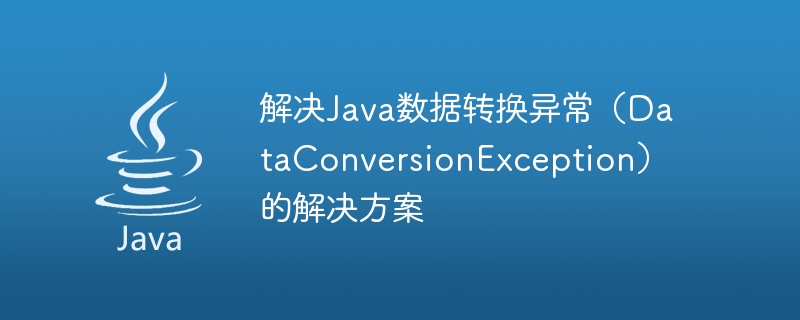Home >Java >javaTutorial >Solution to Java data conversion exception (DataConversionException)
Solution to Java data conversion exception (DataConversionException)
- PHPzOriginal
- 2023-08-18 17:55:442517browse

Solution to Java Data ConversionException
Introduction:
In Java programming, it is often necessary to convert one type of data into another types of data. However, when an error occurs during data conversion, a DataConversionException is thrown. This article will introduce the causes, solutions and some code examples of DataConversionException to help developers better handle this exception.
Text:
The reasons why DataConversionException occurs can be divided into the following situations:
- Data type mismatch: When trying to convert a data type into Another incompatible data type will throw a DataConversionException exception. For example, convert String type data to int type.
- Incorrect data format: When the format of the data is inconsistent with the expected format, a DataConversionException exception will also be thrown. For example, convert a string that cannot be parsed into a date format into a Date type.
- Data range exceeds limit: Some data types have certain range restrictions. When the converted data exceeds the range, a DataConversionException will occur. For example, convert a number outside the range of int type to int type.
The method to solve the DataConversionException exception is as follows:
- Use the appropriate conversion method:
When using the data conversion method, first ensure that the method used is consistent with the method to be converted The data type matches, and the target type has sufficient range to accommodate the converted data. For example, use the Integer.parseInt() method to convert a string into an integer.
The following is a sample code for converting a string to an integer:
String str = "123";
try {
int num = Integer.parseInt(str);
System.out.println(num);
} catch (NumberFormatException e) {
System.out.println("数据转换异常:" + e.getMessage());
}- Use try-catch block to catch exceptions:
When performing data conversion, use try-catch The statement captures the DataConversionException exception and handles the exception in the catch block. For example, output an error message or give a default value.
The following is a sample code to convert the String type to the Date type:
String str = "2022-07-01";
try {
SimpleDateFormat format = new SimpleDateFormat("yyyy-MM-dd");
Date date = format.parse(str);
System.out.println(date);
} catch (ParseException e) {
System.out.println("数据转换异常:" + e.getMessage());
}- Use a type conversion library or tool:
In addition to using the basic data provided by Java In addition to type conversion methods, third-party type conversion libraries or tools can also be used to handle data conversion exceptions. These libraries generally provide more flexible and comprehensive conversion capabilities and are able to handle a variety of complex situations.
For example, use the NumberUtils class in the Apache Commons library for data conversion. The example is as follows:
String str = "123.45";
try {
double num = NumberUtils.toDouble(str);
System.out.println(num);
} catch (NumberFormatException e) {
System.out.println("数据转换异常:" + e.getMessage());
}Conclusion:
In Java programming, handle data conversion exceptions is a necessary skill. This article introduces the causes of DataConversionException exceptions and provides three solutions: using appropriate conversion methods, using try-catch blocks to catch exceptions, and using type conversion libraries or tools. Developers can choose appropriate solutions to handle DataConversionException based on actual needs, thereby improving the robustness and reliability of the program.
Total word count: 477 words
The above is the detailed content of Solution to Java data conversion exception (DataConversionException). For more information, please follow other related articles on the PHP Chinese website!

